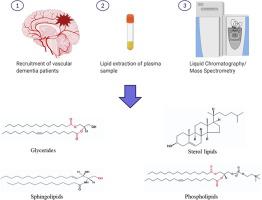Computational and Structural Biotechnology Journal ( IF 4.4 ) Pub Date : 2020-06-09 , DOI: 10.1016/j.csbj.2020.06.001 Yue Liu 1 , Daniel K Y Chan 2 , Anbupalam Thalamuthu 1, 3 , Wei Wen 1 , Jiyang Jiang 1 , Matthew Paradise 1 , Teresa Lee 1 , John Crawford 1 , Matthew Wai Kin Wong 1 , Ying Hua Xu 2 , Anne Poljak 4, 5 , Russell Pickford 4 , Perminder S Sachdev 1, 6 , Nady Braidy 1

|
Vascular dementia (VaD) is a complex neurocognitive disorder secondary to a variety of cerebrovascular lesions. Numerous studies have shown that lipid metabolism is involved in the pathobiology of the disease. We examined the plasma lipid profiles in VaD, with the expectation of identifying reliable lipid biomarkers for VaD. 49 VaD patients and 48 healthy controls were recruited from Bankstown-Lidcombe Hospital in Sydney, Australia. Lipids were extracted by single phase 1-butanol/methanol, and untargeted analysis was performed by liquid chromatography coupled-mass spectrometry (LC–MS/MS). Univariate analysis of variance was used to examine the differences in lipid classes and individual lipids between VaD and control groups. In an independent sample of 161 subjects from the Older Australian Twins Study (OATS), elastic net penalization for the generalized linear model (Glmnet) and Random Forest were applied to the lipid levels to subcategorise the sample into vascular cognitive impairment and controls. Most lipids belonging to the classes of ceramides (Cer), cholesterol esters (ChE) and phospholipids were significantly lower in VaD plasma, while glycerides were elevated compared to controls. Levels of ChE, Cer and the two lipid classes together achieved the best accuracy in discriminating VaD from controls, with more than 80% accuracy. The probable VaD group in the OATS sample predicted by the lipid levels showed greater impairment in most cognitive domains, especially attention and processing speed and executive function from controls but did not differ in white matter hyperintensities and DTI measures. As a conclusion, plasma lipids levels, in particular Cer and ChE, are abnormal in VaD and may help discriminate them from healthy controls. Understanding the basis of these differences may provide insights into the pathobiology of VaD.
中文翻译:

血浆脂质组学生物标志物分析揭示了血管性痴呆中明显的脂质变化。
血管性痴呆(VaD)是继发于各种脑血管病变的一种复杂的神经认知障碍。大量研究表明,脂质代谢与疾病的病理生物学有关。我们检查了VaD中的血浆脂质谱,期望能鉴定出可靠的VaD脂质生物标志物。从澳大利亚悉尼的Bankstown-Lidcombe医院招募了49位VaD患者和48位健康对照。通过单相1-丁醇/甲醇提取脂质,并通过液相色谱-质谱联用(LC-MS / MS)进行非目标分析。使用方差的单变量分析来检查VaD组和对照组之间的脂质类别和单个脂质的差异。在来自澳大利亚老年人双胞胎研究(OATS)的161个受试者的独立样本中,将广义线性模型(Glmnet)的弹性净罚分和随机森林应用于脂质水平,以将样品分类为血管性认知障碍和对照。与对照相比,在VaD血浆中,大多数属于神经酰胺(Cer),胆固醇酯(ChE)和磷脂类别的脂质显着降低,而甘油酯则升高。ChE,Cer和两种脂质类别的水平在区分VaD和对照品方面达到了最高的准确度,准确度超过80%。脂质水平预测的OATS样本中可能的VaD组在大多数认知领域表现出更大的损伤,特别是与对照相比,注意力,加工速度和执行功能,但在白质过高和DTI措施方面没有差异。结论是血浆脂质水平 特别是Cer和ChE,VaD异常,可能有助于将其与健康对照区分开。了解这些差异的基础可能会提供有关VaD病理生物学的见解。











































 京公网安备 11010802027423号
京公网安备 11010802027423号